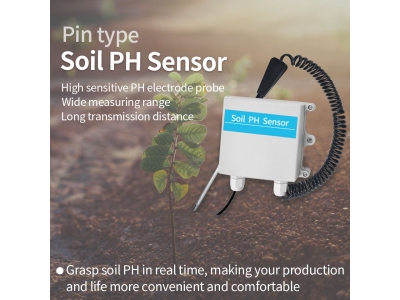Precision agriculture, also known as smart farming or digital farming, revolutionizes traditional farming methods by incorporating advanced technologies to optimize crop production. One of the key components of precision agriculture is the use of soil sensors. These sensors provide valuable data about soil conditions, enabling farmers to make informed decisions regarding irrigation, fertilization, and overall crop management. This article explores how soil sensors contribute to precision agriculture, their benefits, and potential applications.
The Role of Soil Sensors in Precision Agriculture
2.1. Soil Data Collection
Soil sensors are devices that measure various soil parameters, including moisture content, temperature, pH level, nutrient levels, and salinity. By collecting real-time data on these soil characteristics, farmers can gain insights into the soil's health and fertility. Soil sensors are typically installed in the field at different depths to capture a comprehensive view of the soil profile. The collected data is then transmitted to a central database or displayed on a mobile device for analysis and interpretation.

2.2. Data Analysis and Interpretation
The data collected by soil sensors is analyzed and interpreted using specialized software or agricultural platforms. These tools allow farmers to visualize the soil data through graphs, charts, and maps, making it easier to identify patterns and trends. Advanced analytics can provide recommendations and insights based on historical data, scientific models, and crop-specific requirements. By understanding the soil conditions more accurately, farmers can optimize their farming practices and achieve higher crop yields.
Benefits of Soil Sensors in Precision Agriculture
3.1. Water Management Optimization
Proper water management is crucial for crop growth and yield. Soil sensors provide real-time information on soil moisture levels, helping farmers determine when and how much to irrigate. By avoiding under- or over-irrigation, farmers can optimize water usage, conserve resources, and reduce costs. Additionally, precise irrigation control based on soil sensor data minimizes the risk of waterlogging and nutrient leaching, leading to healthier plants and improved water efficiency.
3.2. Nutrient Management Enhancement
Soil sensors play a vital role in optimizing nutrient management. By monitoring nutrient levels in the soil, farmers can adjust their fertilization practices accordingly. Rather than applying fertilizers uniformly across the entire field, precision agriculture allows for site-specific nutrient application. Soil sensors provide data that indicates nutrient deficiencies or excesses in different areas of the field, enabling farmers to apply fertilizers only where they are needed. This targeted approach reduces fertilizer waste, minimizes environmental impact, and improves nutrient uptake by crops.
3.3. Disease and Pest Management
Soil conditions can influence the prevalence of diseases and pests. Soil sensors help detect early signs of disease or pest pressure by monitoring changes in soil moisture, temperature, and other relevant parameters. By identifying potential issues promptly, farmers can take preventive measures, such as adjusting irrigation practices or applying appropriate treatments, to mitigate the risk of disease outbreaks and pest infestations. Timely interventions based on soil sensor data can minimize crop damage and reduce reliance on chemical pesticides.
3.4. Yield Optimization and Cost Reduction
Precision agriculture, facilitated by soil sensors, enables farmers to optimize crop yield while reducing costs. By tailoring irrigation, fertilization, and other management practices to specific areas within a field, farmers can maximize the productivity of each square meter of land. The ability to detect variations in soil conditions allows for precise adjustments, resulting in higher-quality crops and increased yields. Moreover, by minimizing resource wastage, such as water and fertilizers, farmers can significantly reduce production costs and improve overall profitability.
Applications of Soil Sensors
4.1. Variable Rate Application
Variable rate application (VRA) is a technique that adjusts the application rates of inputs based on site-specific requirements. Soil sensors provide the necessary data for implementing VRA in precision agriculture. For example, based on soil moisture levels, a VRA system can deliver more water to areas experiencing drought stress and less water to adequately hydrated regions. This approach optimizes resource utilization and promotes uniform crop growth across the field.
4.2. Irrigation Scheduling
Soil sensors play a vital role in determining irrigation schedules. By continuously monitoring soil moisture levels, the sensors can provide accurate information on when irrigation is needed. This data-driven approach ensures that crops receive optimal water supply, preventing both water stress an





